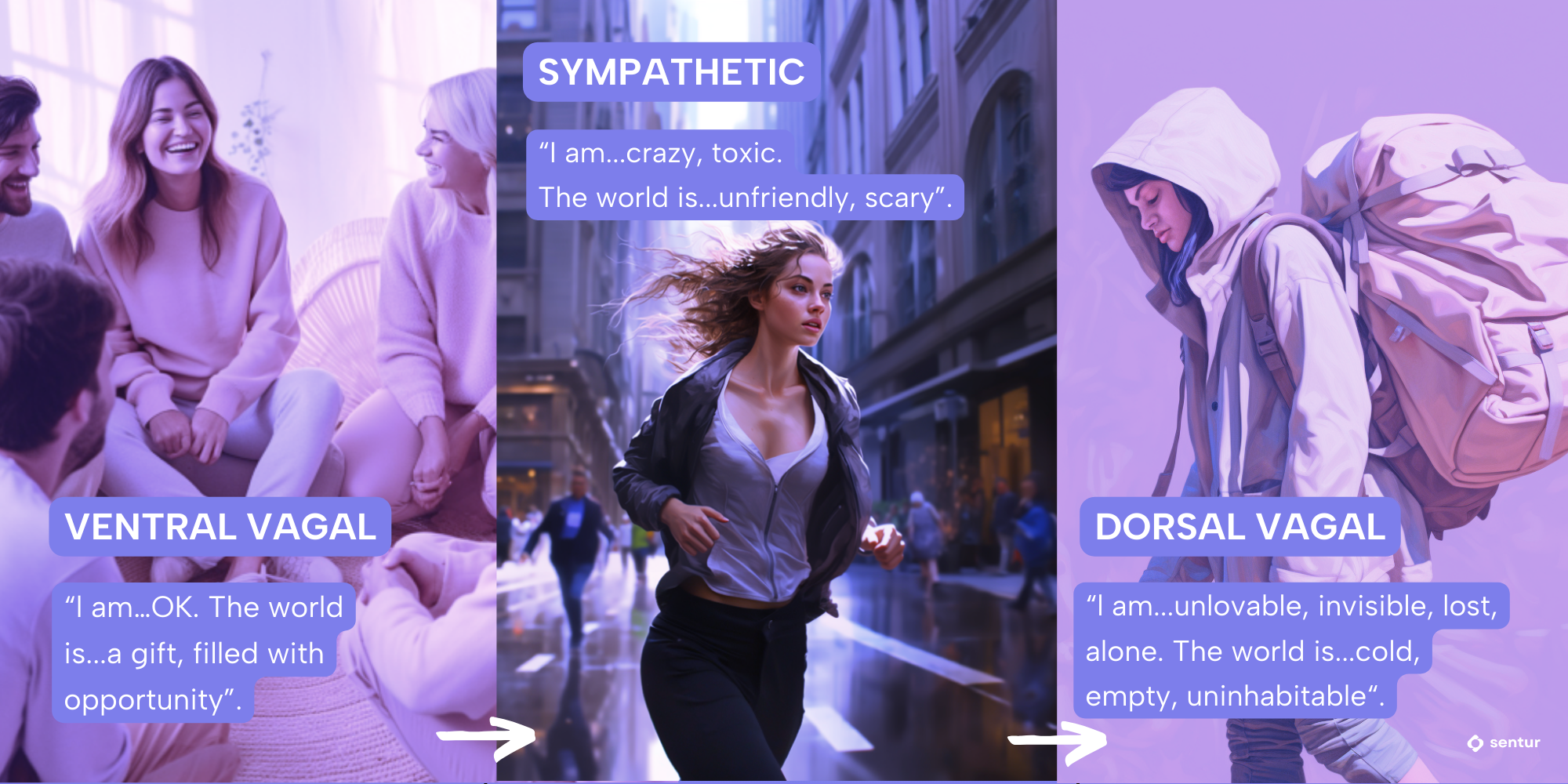Why Gratitude Isn't Always Easy: Unpacking the Protector's Role
Article Summary
Do you want to access gratitude to help improve your overall well-being? And yet do you also paradoxically feel that gratitude may be the “greatest of all virtues”, but the more you try, the farther away it feels?
You’re not alone. Gratitude is quite elusive and activating for many of us, especially trauma survivors.
In this article, I will share with you:
The science and soul of why gratitude is tricky for trauma survivors
What blocks our access to gratitude and the therapeutic hack for this
Our fresh perspective on gratitude
3 steps to help unlock your journey with gratitude
“Gratitude is quite activating and elusive for many of us, especially trauma survivors.”
The Science and Soul: Why Gratitude is a Challenge
The Science: The Polyvagal Theory and Gratitude
You may often hear about the transformative power of gratitude and its ability to enhance our lives. But if you're a trauma survivor, you might also know that accessing gratitude isn't always straightforward. It's like trying to hold water in your hands, and the more you try, the more elusive it feels. You're not alone in this struggle, and as a trauma treatment specialist and survivor, I've navigated this complex terrain and am here to guide you through it.
For trauma survivors, gratitude can feel like a foreign language. It's not just about saying "thank you", or buying a gratitude journal; it's about experiencing life as a gift – a concept often at odds with a trauma response.
The polyvagal theory, developed by the trauma treatment pioneer Dr. Stephen Porges, suggests that depending on what state of trauma response your nervous system is in, certain nervous system states inhibit the warmth and openness required for gratitude. As you see in the image, It is our ventral vagal system that allows us to be able to experience life as a gift, connect with others around us, and be in a place of deep appreciation.
This is something that is already inside you. You do not need to build up your gratitude. You need to gain access to that. I’ll show you some strategies below.
So the science behind this is when you are in one gear in your nervous system, you can’t be in another. It’s like a car being in 2nd and 3rd gear simultaneously. It’s not possible. You can choose one gear at a time for the engine of your vehicle. Likewise, your nervous system can select one gear.
And if you are a trauma survivor more than likely you are pinned in either sympathetic arousal or dorsal vagal shutdown. Not the cushy ventral vagal gear.
The Soul: How Gratitude Can Feel Inside
Gratitude can feel like a four-letter word, even though it is 9 letters. If any of these responses are what comes up when you explore the concept of gratitude inside, you are not alone.
When I surveyed our online and in-person community about gratitude:
“Overwhelming”
“ I am not grateful for my trauma or the things that have happened to me”
“If you weren’t such a piece of %$^ then I would’t suffer like I do.” (anger, criticism)
“I can’t be grateful, because I don’t have what I want and I will never get what I want. Like a stable relationship, or feeling loved in this world.” (pessimism)
“Gratitude was used as a tool of abuse”
“I should just be grateful for what I have, it could be so much worse.” (toxic positivity)
“#$%^ gratitude” (anger)
“Maybe if I would have been better, I could get what I want.” (shame, inner criticism)
“Name 3 things you're grateful for right now. Well, you can only list food, water, and shelter so many times before you lose your &^%$(!$ mind.”
“Recognizing these protectors and understanding their role is not about force-feeding ourselves gratitude; it’s about gently releasing the gratitude already there, waiting to be felt.”
It Is Our Light Not Our Darkness: Gratitude Is Extremely Uncomfortable For Many
Feeling joy, love, gratitude, connection, or anything from that healing energy of Self can be highly uncomfortable. Here are three reasons why the light, not the darkness, is challenging:
Gratitude is vulnerable.
Vulnerability is unpredictable. In comparison to depression, pain and shame for many become a predictable way of life.
We have experienced pain associated with vulnerability.
When we grow up in a home where household dysfunction, neglect, abuse, etc was present we can start to experience direct or indirect avoidance of positive experiences. You might believe inside that if you open yourself up, or your parts open up space, you are guaranteed to hurt. Or you may have experienced pain directly associated with being in a place of connection such as trust and then someone betrays you that you love.
We don’t get to pick and choose with a trauma response. Your system will either code open-heartedness as unsafe or unpredictable and in either case it will do a hell of a lot to keep you safe and ok, and thus cutting you off from that experience of gratitude.
Therapeutic Hack: If you are a healer working with trauma survivors, please make sure to tell them that the joy and gratitude are going to be as much work to tolerate as the pain and the shame. This is extremely important because oftentimes, as people “do their work”, they come to believe that once they experience joy and love and connection and gratitude, they have reached the holy grail and are in the clear. Not true.
The famous Marianne Williamson quote, “It is our light, not our darkness, that frightens us most,” applies well here. Reworded through the lens of IFS would be “It is our Self-energy, not our pain, that frightens our protectors most”.
Working with these protectors who are frightened by Self-energy by building awareness, getting into relationship with, and liberating them from their protective roles will help your inner world start to build tolerance for the light, Self, and gratitude naturally within you
“When we lose our tolerance for vulnerability, joy becomes foreboding. No emotion is more frightening than joy, because we believe if we allow ourselves to feel joy, we are inviting disaster.”
Protectors: Understanding the Blocks to Gratitude
According to the Internal Family Systems theory, pioneered by Dr. Richard Schwartz, who we are as humans is naturally multiple, and that is a good thing. We have multiple parts, or sub-personalities, and a core Self, our healing energy. These “thieves of thankfulness” like anger, criticism, cynicism, and the like, are parts of us and more specifically, they are what we could identify as protectors.
Our protectors – anger, criticism, cynicism, and the like – shield us from pain that is trapped in our system by things that we have experienced in our lives. Ironically, they also block the gratitude and healing energy within us (Self). In the youtube below, I walk you through how better to understand the blocks to gratitude in your life taking three important steps in the ARC of Self-transformation. Linking the polyvagal theory described above, working with your protectors will allow you to shift in your nervous system from either a dorsal vagal shutdown or sympathetic activation into your ventral vagal system.
Recognizing these protectors and understanding their role is not about force-feeding ourselves gratitude; it's about gently releasing the gratitude already there, waiting to be felt. It takes some intentionality, and I’ll show you how.
Unlocking Gratitude: A Practical Guide
Using the ARC of Self-transformation as your guide, there are 3 steps you can take TODAY to help access the gratitude already within you.
Bring awareness to your inner experience of gratitude.
Do a free write of 5-10 minutes. No filtering, no stopping, just writing for 5-10 minutes on gratitude.
Bring awareness to the body sensations, emotions and beliefs you wrote about.
Circle the body sensations and emotions.
Underline the beliefs.
Star the aspect of your self-reflection that is most calling to you.
Ask this part of your experience if it is willing to give you some space so you can bring curiosity toward it.
Let’s say cynicism is the emotion that you noticed most drawn to that you starred, then you will want to ask the part of you that is holding that role of cynicism in your system if it is willing to give you some space. Enough space so that you naturally start to feel curious toward it.
Now, this is not the end of the road for this, but if you are in a place where you can bring curiosity TOWARD the experience that gets activated around gratitude in your system, you are 70% of the way there toward being able to access it.
Windshields and Gratitude: A Note of Compassion
You cannot experience gratitude in the windshield as easily as you can in the rearview mirror.
Your parts will not allow you to experience gratitude when they are in pain, nor do they want to hear it from you, just like real people do not want to hear it from you when they are in pain. When we are in the thick of our pain, we need compassion, clarity, and consistency from the people around us, and this is what our inner system needs too. Gratitude is an aspect of post-traumatic growth. A rearview mirror experience. Not a traumatic response, windshield experience.
Use the steps above when you have the trauma a bit in your rearview mirror. And that will be personal to you. It could be a day. It could be 30 years. Whatever works for you.
Embracing Gratitude: A Lifelong Journey
As we conclude, remember that a relationship with gratitude is a journey. One that doesn’t culminate with one single decision or act. It is a balance with every topic, in every way. So remember, gratitude is tricky for most trauma survivors.
And the stakes couldn’t be higher. For individuals who have experienced trauma and have not found resolution, there is a direct correlation to physical suffering, (read The Body Keeps The Score or When The Body Says No) and shortened lifespan, sometimes upwards of 20 years!
Being able to unlock access to the profound experience of gratitude at the center of your being can enhance your well-being, improve your longevity, and be a massive influence on how you handle current and future things in your life. It can be a significant key to living the thriving life you deserve.
By exploring the intricate dance between our protective parts and our innate capacity for gratitude, we can use the experience of gratitude to transform our trauma into a source of strength.
So join us as a community of seekers and healers on the journey of liberation to the thriving life we all desire. Whether it's our free community classes, our wealth of free resources online, or utilizing our #1 trauma recovery support platform, Sentur, we want you to know we see you, believe in you, and are here to support you.
Always in your corner,
Sarah
You deserve to thrive.
We’re here to help.
Comprehensive, accessible Internal Family Systems resources for your journey of self-transformation.





